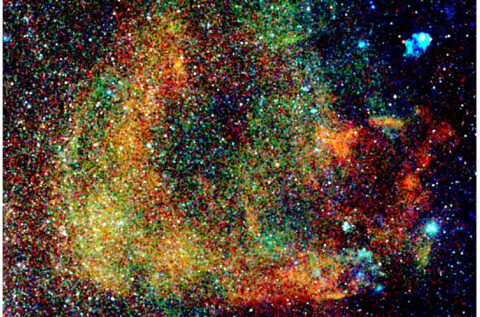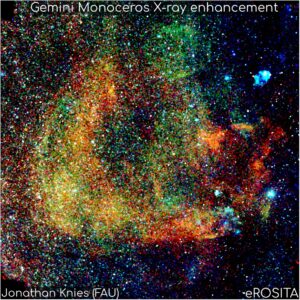Largest catalog of high-energy cosmic sources published

Star corpses, jets of matter and white dwarfs
Supernova remnants, black holes, neutron stars and the hot interstellar gas of the Milky Way and other galaxies – the sky is full of sources that emit X-rays. Researchers at the Dr. Karl Remeis Observatory – Astronomical Institute of the Erlangen Centre for Astroparticle Physics (ECAP) at FAU, as one of the core institutes of the German eROSITA consortium, scoured the sky for such sources from 2019 to 2022 with the help of an X-ray telescope. The consortium has now published the largest catalog of X-ray sources to date in the journal Astronomy & Astrophysics.
As many as in 60 years before
The eROSITA X-ray telescope on board the Spektrum-RG satellite discovered around 900,000 X-ray sources during the first sky survey from December 2019 to June 2020. With the help of the telescope, the researchers were already able to discover more radiation sources in this first survey than in the entire sixty-year history of X-ray astronomy. The first eROSITA All-Sky Survey Catalog (eRASS1) is thus the largest collection of X-ray sources ever published. The researchers created the catalog after processing and calibrating the collected data by detecting photon concentrations in the sky against a large-scale, bright and diffuse background.
The eRASS1 catalog covers one half of the X-ray sky and is the data portion of the German eROSITA consortium. It includes about 710,000 supermassive black holes, i.e. active nuclei of distant galaxies, over 180,000 X-ray stars in our own Milky Way, 12,000 galaxy clusters and a small number of other exotic sources such as X-ray emitting binary stars, supernova remnants, pulsars and other objects. “The data that is now available to the global scientific community will revolutionize our knowledge of the universe at high energies,” says Prof. Manami Sasaki, Professor of Multiwavelength Astronomy at FAU. The other half of the data will be analyzed by the Russian scientists.
The first eRASS data publication contains not only the catalog of sources, but also images of the X-ray sky at various energies as well as lists of the individual photons detected with their sky positions, energies and exact arrival times. The software required to analyze the eROSITA data is also included in the publication. For many types of sources, additional data from other wavebands were also included in so-called “value-added catalogs”, the contents of which go beyond pure X-ray information. Along with the data, the consortium published a number of scientific papers on new results, ranging from studies on the habitability of planets to the discovery of the largest cosmic structures.

Extended X-ray emission in the sky caused by supernova explosions in our neighborhood.
Scientists at FAU have gained fascinating insights into the X-ray sky. Federico Zangrandi, a doctoral student at the Dr. Karl Remeis Observatory, FAU’s Institute of Astronomy at the Department of Physics, has studied the remains of dying stars, so-called supernova remnants, in the Large Magellanic Cloud. This is the largest companion galaxy to our Milky Way. “We have found many new supernova remnants in the Large Magellanic Cloud, especially in its periphery. This is an indication that stars have either been ejected from the cloud or torn out by tidal interaction between it and the Milky Way.”
Aafia Zainab, on the other hand, is researching the X-ray radiation from neutron stars and black holes in the Milky Way. “These sources are created in the supernova explosion at the end of the evolution of massive stars,” explains the doctoral student. With eROSITA, we have succeeded in identifying dozens of new sources of this type.” PhD student Philipp Weber is also interested in such stellar corpses, but in other galaxies. “For the first time, eROSITA has observed many thousands of known galaxies in X-rays,” he explains. In the process, he has found radiation sources in these galaxies that can reach brightnesses of more than 100,000 times that of our sun. “These sources are very rare, only a few percent of all galaxies contain such sources.”
Many galaxies contain a black hole with many millions of solar masses in their center. These are called blazars. “Such black holes can eject matter in the form of so-called jets at speeds close to the speed of light,” says Steven Hämmerich, who studied blazars in his doctoral thesis and was able to detect several thousand of these jets of matter with eROSITA.
Thanks to its large field of view and high sensitivity at lower X-ray energies, eROSITA is also very suitable for studying extended X-ray emission in the sky. For the first time, researchers now have data to study the population of X-ray sources in the Milky Way’s nearest companion galaxies. “We find white dwarfs and neutron stars in binary stars that are sucking up matter from their companions,” says Dr. Sara Saeedi, research associate at the Chair of Multiwavelength Astronomy.
German-Russian satellite in sleep mode
The team led by FAU astronomers Prof. Dr. Manami Sasaki and Prof. Dr. Jörn Wilms, both based at the observatory and at ECAP, worked on the development of the eROSITA X-ray telescope, for which researchers from several German universities joined forces under the leadership of the Max Planck Institute for Extraterrestrial Physics (MPE) and the German Aerospace Center (DLR). The project was realized together with Russian researchers from the space agency Roskosmos and the Russian Academy of Sciences, represented by its Institute of Space Research (IKI).
Between June 2020 and February 2022, the sky was scanned three more times. The scientists will also process some of the data obtained and make it available to the public in the future. The satellite has been in safe mode since February 2022 and scientific operations have not been resumed since then.
Further information:
Dr. Sara Saeedi
Professur für Multiwellenlängenastronomie
sara.saeedi@fau.de
Prof. Dr. Manami Sasaki
Professur für Multiwellenlängenastronomie
manami.sasaki@fau.de
Prof. Dr. Jörn Wilms
Lehrstuhl für Astronomie und Astrophysik
joern.wilms@fau.de